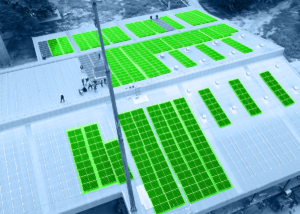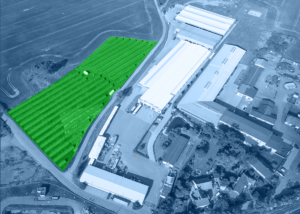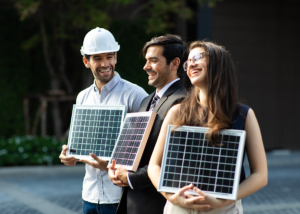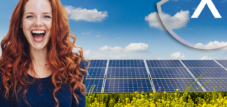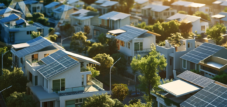Solar/photovoltaics: On the way to energy self-sufficiency with micro grids - construction rules for solar systems from small systems to large projects
Language selection 📢
Published on: July 2, 2023 / update from: July 2, 2023 - Author: Konrad Wolfenstein
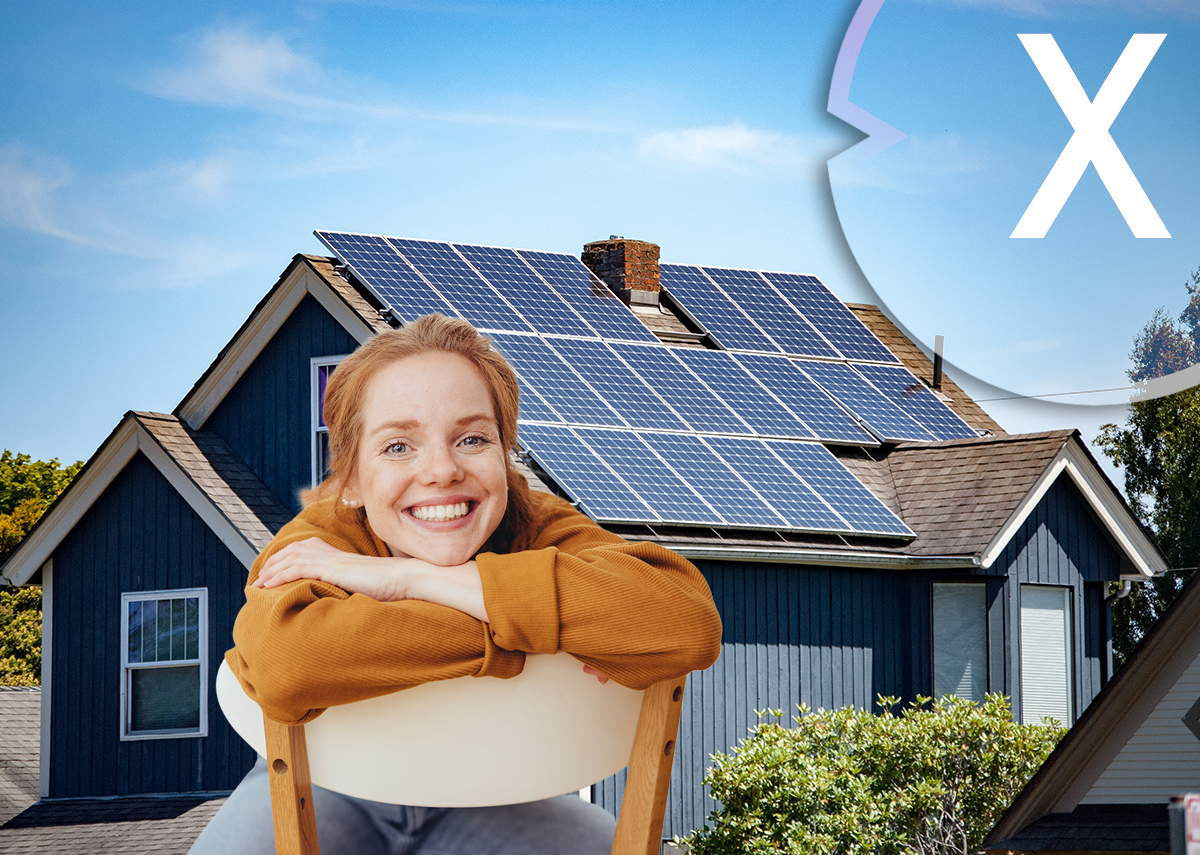
On the way to energy self-sufficiency: Construction rules for solar systems - from small systems to large projects - Image: Xpert.Digital
On the way to energy self-sufficiency: Construction rules for solar systems - from small systems to large projects
The energy transition has highlighted the need for sustainable and decentralized energy production. One of the central pillars of this transformation is solar energy. Solar systems offer an environmentally friendly and renewable energy source that makes it possible to become less dependent on fossil fuels. Whether for private households, commercial businesses or large energy projects, the construction of solar systems requires compliance with certain construction rules.
Location analysis
Choosing the right location is a crucial factor for the success of a solar system. It is important that the location receives sufficient sunlight and is not affected by shadows or obstacles. A detailed analysis of the solar radiation and the nature of the terrain helps to determine the optimal location for the solar system.
Technical planning and dimensioning
The technical planning of a solar system includes the selection of suitable solar modules, inverters and mounting systems. Correct sizing of the system is crucial to meet energy needs and ensure efficient use of solar energy. A careful calculation of the required module area, the optimal inclination and alignment of the modules as well as the cable routes and connection technology is essential.
Approvals and legal framework
The construction of solar systems is subject to certain approval procedures and legal requirements in many countries. It is important to find out about local building regulations, zoning regulations, grid feed rules and other legal frameworks. Obtaining the necessary permits and adhering to the specifications ensure smooth and legally compliant operation of the solar system.
Security and maintenance
The safety of people and system operation is of great importance. Installing safety devices such as guards and locking systems is essential. In addition, regular maintenance and inspection of the system should be carried out to ensure long-term efficiency and trouble-free operation. This includes cleaning the solar panels, checking the wiring and inspecting the inverters.
Financing and profitability
Financing a solar system can be challenging. There are various financing options such as personal investments, loans or leasing models. Calculating the economic viability of the system, taking into account feed-in tariffs, electricity cost savings and funding programs, is crucial. A realistic cost-benefit analysis helps in making decisions and selecting the appropriate financing model.
Integration into the power grid
The integration of solar systems into the power grid requires consideration of the grid connection conditions and compliance with the technical requirements. Proper cabling, the use of suitable inverters and coordination with the grid operator are important steps to ensure a stable and reliable feed-in of solar energy.
Environmental impact and sustainability
The construction of solar systems is a sustainable measure for energy production. Solar systems do not produce harmful emissions and help reduce greenhouse gas emissions. Nevertheless, it is important to pay attention to environmental compatibility and recyclability when selecting materials and components.
➡️ The construction of solar systems from small systems to large projects requires careful planning, technical expertise and compliance with construction rules. By selecting the right location, observing the legal framework, ensuring system safety and taking economic viability into account, solar systems can be operated efficiently and sustainably. The path to energy self-sufficiency is paved by the expansion of solar systems as an important contribution to decentralized and renewable energy production.
Plan your solar system for the most common applications conveniently online with our solar system planner!
With our user-friendly solar system planner you can plan your individual solar system online. Whether you need a solar system for your home, your business or for agricultural purposes, our planner offers you the opportunity to take your specific requirements into account and develop a tailor-made solution.
The planning process is simple and intuitive. You simply enter relevant information. Our planner takes this information into account and creates a tailor-made solar system that meets your needs. You can try out different options and configurations to find the optimal solar system for your application.
Additionally, you can save your plan to review later or share with others. Our customer service team is also available to answer your questions and provide support to ensure your solar system is optimally planned.
Use our solar system planner to plan your individual solar system for the most common applications and advance the transition to clean energy. Start now and take an important step towards sustainability and energy independence!

The solar system planner for the most common applications: Plan the solar system online here - Image: Xpert.Digital
More about it here:
How important is energy self-sufficiency?
Energy self-sufficiency, i.e. the ability to cover one's own energy needs independently and sustainably, is playing an increasingly important role for the future. Given limited fossil fuel resources, increasing energy needs and climate change, it is crucial to develop alternative energy sources and create a sustainable energy cycle. Energy self-sufficiency offers numerous advantages, including environmental protection, reduced energy costs and increased security of supply.
In order to achieve energy self-sufficiency, various measures and technologies are required. One of the most important is the increased use of renewable energies such as solar energy, wind energy, hydropower, biomass and geothermal energy. These energy sources are inexhaustible, low in emissions and offer great potential for sustainable energy supply. The expansion of renewable energy requires investments in infrastructure, the development of efficient energy storage systems and the promotion of research and innovation to further improve their efficiency and reliability.
Solar energy plays a particularly important role in energy self-sufficiency. By using solar cells to convert sunlight into electricity, homes, businesses and even entire communities can generate their own electricity. Advances in solar cell technology, such as the development of efficient thin-film solar cells and the integration of solar cells into building facades, offer new opportunities for using solar energy. Additionally, solar batteries can be used to store excess energy and use it when the sun is not shining.
Wind energy also plays an important role in energy self-sufficiency. Wind turbines generate electricity from the kinetic energy of the wind and can provide a significant amount of energy depending on location and size. The further development of wind power technologies and the use of offshore wind farms expand the possibilities for using wind energy. In addition, combining wind energy with other renewable energies such as solar energy and hydropower is an effective way to ensure a continuous power supply.
Another important component for energy self-sufficiency is energy efficiency. Through the efficient use of energy, energy requirements can be reduced and costs can be reduced. This includes measures such as improving building insulation, using energy-efficient appliances and implementing smart energy networks that optimize energy consumption. Energy efficiency helps reduce the need for energy production and thus facilitates the transition to a self-sufficient energy supply.
Decentralized energy production and distribution also plays an important role in energy self-sufficiency. By creating microgrids, small autonomous power grids that harness and store locally generated renewable energy, communities can operate independently of the main power grid. Microgrids offer increased security of supply because they can continue to supply energy in the event of disruptions to the main grid. They also enable the exchange and sharing of excess energy between participants, resulting in more efficient use of the energy generated.
However, the path to energy self-sufficiency requires not only technological advances, but also political and social support. Governments should create incentives to promote the expansion of renewable energy, facilitate investment in sustainable energy projects and support the transition to energy self-sufficiency. Education and awareness-raising are also crucial to promote understanding of sustainable energy concepts and strengthen society's commitment to energy self-sufficiency.
➡️ Energy self-sufficiency is of great importance for the future. By increasing the use of renewable energies, improving energy efficiency and creating decentralized energy systems, we can achieve a sustainable and independent energy supply. This not only helps reduce environmental impacts, but also creates jobs in the green economy, strengthens energy security and promotes overall sustainable development. However, it requires a holistic approach that takes technological, political and social aspects into account in order to successfully make the transition to energy self-sufficiency.
Decentralized energy generation and microgrids: The path to energy self-sufficiency and sustainable supply
Decentralized energy production and distribution through microgrids is playing an increasingly important role in energy self-sufficiency. Microgrids are small, autonomous power grids that can use and store locally generated renewable energy. Unlike the traditional centralized power grid, microgrids enable communities and businesses to operate independently of the main power grid and control their own energy supply.
Microgrids offer increased security of supply because they can continue to supply energy in the event of disruptions to the main grid. This is particularly important in regions with unstable power supplies or in situations where natural disasters or other disruptions can cause power outages. By using locally generated renewable energy, such as solar or wind energy, microgrids can also ensure reliable power supply even when the main grid is unavailable.
Another advantage of microgrids is that they enable the exchange and sharing of excess energy between participants. If a community or business produces more energy than is needed, the excess can be fed into the microgrid and used by other participants. This promotes more efficient use of the energy produced and reduces the need for additional energy sources. In addition, excess energy can be stored in batteries or other storage systems for use when generation is insufficient.
The implementation of microgrids requires the use of intelligent power distribution systems and advanced control technologies. By using smart grids, microgrids can monitor energy flow, optimize energy production and distribution, and minimize the demand for energy from the main grid. Using advanced control technologies, energy flows can be monitored and controlled in real time to ensure efficient use of renewable energy sources.
Implementation of microgrids can occur in both urban and rural areas. In rural areas where access to the main electricity grid can be limited or expensive, microgrids offer a cost-effective and sustainable alternative. In urban areas, microgrids can help promote local energy production, reduce carbon emissions and ensure reliable electricity supply.
However, achieving energy self-sufficiency requires more than just the creation of microgrids. There is also a need for a holistic energy transition that includes expanding renewable energy, improving energy efficiency, implementing intelligent energy networks and promoting research and development. In addition, political support, incentive systems and social commitment are of great importance in order to enable the transition to a decentralized, sustainable energy supply.
➡️ Decentralized energy production and distribution through microgrids plays an important role on the path to energy self-sufficiency. Microgrids offer security of supply, promote the use of renewable energies and enable more efficient use of the energy generated. They represent an innovative solution to make communities more independent of the main electricity grid and forge a sustainable path to an energy future.
Alternatives to decentralized energy production and distribution: Diverse paths to energy self-sufficiency
In addition to smart grids and microgrids, there are also other alternatives and approaches to decentralized energy production and distribution.
Virtual power plants
Virtual power plants are combinations of decentralized energy generation systems that are coordinated via a central control system. Through the intelligent networking of solar systems, wind farms, biomass systems and other renewable energy sources, virtual power plants can optimize the energy flow and distribute the energy generated efficiently.
Peer-to-peer energy trading
This innovative solution allows consumers to trade energy directly with one another. Using blockchain technology, producers can sell their excess electricity to other consumers without the need for a central power company as an intermediary. Peer-to-peer energy trading promotes local energy production and strengthens consumer independence.
Local energy storage
Energy storage systems such as batteries and accumulators play a crucial role in decentralized energy supply. They allow excess energy to be stored for times when energy production is lower or demand is higher. By using local energy storage, energy self-sufficiency can be improved and dependence on the main power grid can be reduced.
Demand response
Demand response refers to adapting energy consumption to the availability and prices of energy. Intelligent control systems allow consumers to flexibly adjust their energy demand to avoid peak loads or benefit from cheaper tariffs. This achieves better utilization of energy generation systems and improves the efficiency of energy consumption.
Local Energy Communities
Local energy communities are associations of consumers who produce, distribute and use energy together. These communities can use different energy sources such as solar panels, wind turbines and biomass systems and share the energy produced among themselves. Local energy communities promote cooperation and exchange of energy within a community and strengthen energy self-sufficiency.
➡️ These alternatives offer different approaches to decentralized energy production and distribution. Depending on the needs and circumstances of a region or community, different combinations of these approaches can be used to create a sustainable and energy self-sufficient future.
What are the similarities and differences between smart grids and micro grids
Commonalities
- Energy efficiency: Both smart grids and microgrids aim to improve energy efficiency and optimize energy consumption.
- Renewable energy integration: Both concepts enable the integration of renewable energy into the power grid, resulting in more sustainable energy production.
- Technological components: Both smart grids and microgrids use advanced technologies such as sensors, smart meters and energy management systems to monitor the flow of electricity, manage demand and ensure grid stability.
differences
- Size and scalability: Smart grids are large-scale power networks that can cover entire cities or regions. They are designed to serve a wide range of energy consumers and optimize power flow on a system-wide level. Microgrids, on the other hand, are smaller autonomous power grids that operate at a local level and typically serve a limited number of energy consumers.
- Self-sufficiency and independence: While smart grids are still connected to the central power grid and enable energy exchange, microgrids are designed to be autonomous and independent. If necessary, they can be disconnected from the main supply and use and store locally generated renewable energy.
- Flexibility and adaptability: Smart grids are designed to adapt to changing energy needs and sources. You can dynamically control the flow of electricity and react to fluctuations in demand and supply. Microgrids offer greater flexibility because they can be tailored to the specific needs of a particular community or location.
- Renewable energy scalability: Smart grids can integrate a greater variety and quantity of renewable energy because they have larger resources and infrastructure. Microgrids are typically limited to a limited number of renewable energy sources that are locally available.
- Regulation and operation: The regulation and operation of smart grids is typically carried out by large energy utilities and regulatory authorities. Microgrids can be managed by municipalities, companies or private operators and offer more local control and freedom of choice.
➡️ Smart grids and microgrids pursue similar goals, but offer different approaches in terms of size, self-sufficiency, flexibility and scalability. However, both concepts play an important role in promoting a sustainable energy supply and the realization of decentralized energy production and distribution.
- Warehouses, production halls and industrial halls with their own power source from a photovoltaic roof system - Image: NavinTar|Shutterstock.com
- Industrial plant with its own power source from an outdoor photovoltaic system - Image: Peteri|Shutterstock.com
- Plan solar systems with photovoltaic solutions for freight forwarding and contract logistics
- B2B solar systems and photovoltaic solutions & advice
- Plan photovoltaics for warehouses, commercial halls and industrial halls
- Industrial plant: Plan a photovoltaic open-air system or open-space system
- Plan solar systems with photovoltaic solutions for freight forwarding and contract logistics
- B2B solar systems and photovoltaic solutions & advice
With Xpert.Solar your individual solar system solution
I would be happy to serve as your personal advisor.
You can contact me by filling out the contact form below or simply call me on +49 89 89 674 804 (Munich) .
I'm looking forward to our joint project.
Xpert.Digital – Konrad Wolfenstein
Xpert.Digital is a hub for industry with a focus on digitalization, mechanical engineering, logistics/intralogistics and photovoltaics.
With our 360° business development solution, we support well-known companies from new business to after sales.
Market intelligence, smarketing, marketing automation, content development, PR, mail campaigns, personalized social media and lead nurturing are part of our digital tools.
You can find out more at: www.xpert.digital – www.xpert.solar – www.xpert.plus



